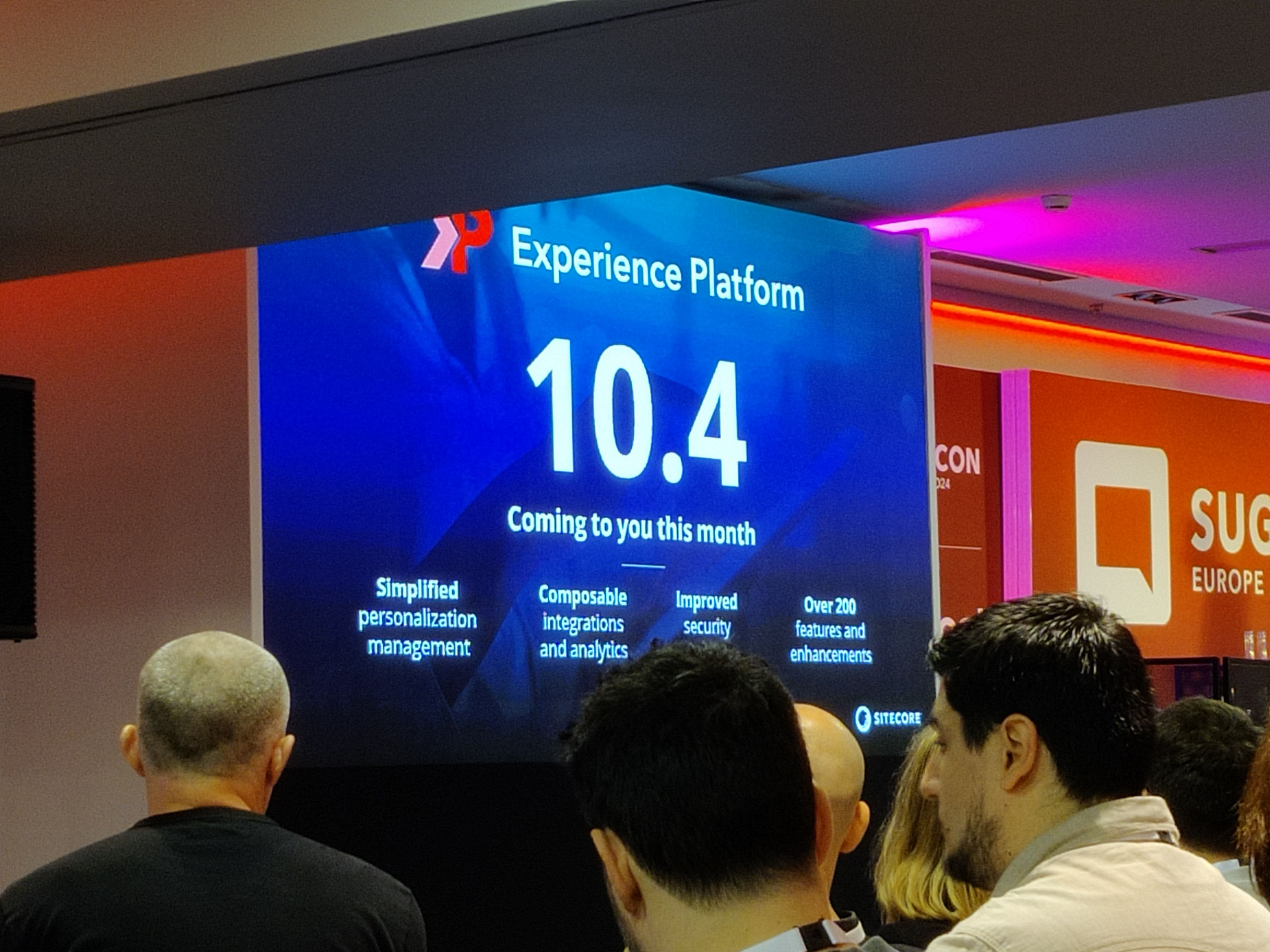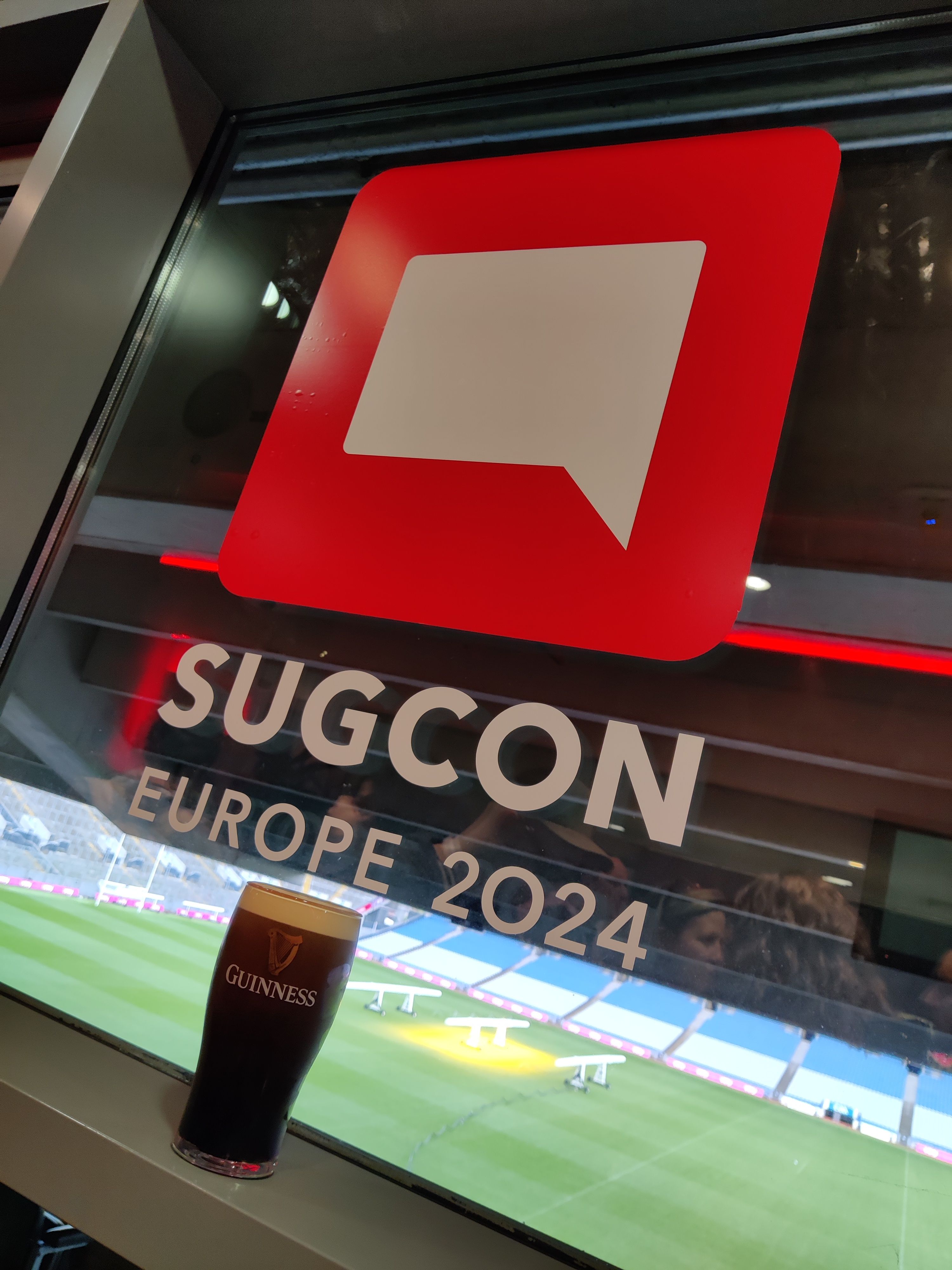Recap SUGCON

Recap
Recap SUGCON 2024
Dublin 2024: The spaces of Croke Park Stadium invite you to the 10th Sitecore User Group Conference (SUGCON) and of course webit! couldn't miss it! That's why our developers Mario and Maik set off to the Irish capital and brought back plenty of news and insights from presentations and the community. Dominant topics included User Experience, Best Practices from various fields, and AI in Sitecore. You can read about this and what a wheel of fortune and Rock'n'Roll have to do with Sitecore in our recap.
The keynote
The conference kicked off with a keynote by Dave O’Flanagan, former Chief Product Officer and recently appointed Sitecore CEO. O’Flanagan first spoke about the Sitecore ecosystem, which now includes over 25,000 developers and spans the entire globe.
Subsequently, he announced the ongoing support for XM and XP products. Customers should continue to have the choice between traditional and cloud-based hosting. O'Flanagan outlined a vision of simplification and innovation for the coming years. Overall, the user experience for marketing teams, as well as the developer experience for development teams, is intended to be improved.
Impressive was the list of a total of 200 features and improvements of Sitecore 10.4, which was still about two weeks away from release at the time of the keynote. O'Flanagan also mentioned that work on 10.5 was already underway.

At the end of the presentation, the Sitecore CEO handed over the stage to Roger Connolly, who recently succeeded him as Chief Product Officer. Connolly emphasized the future role of AI in improving the workflows of marketers and maintaining brand consistency through automated tools. Sitecore plans to enhance AI features in its Digital Experience Platform (DXP), including new features for content and image creation that align with brand guidelines and are expected to be introduced by the end of the year.
Thursday: Opportunities, Experiences, and a Wheel of Fortune
After the opening, our two developers started the presentations with a talk by Pieter Brinkman. He vividly demonstrated how to create a special user experience with XM Cloud and Sitecore Connect, making it easy to support marketing teams. Brinkman showcased a wheel of fortune game where participants could sign up via QR code and form. This form was connected to the wheel of fortune application, which determined the winner. XM Cloud was used for an appealing landing page, Sitecore Send for direct email sending through the platform. Connect handled important functions such as input validation and saving contact details in a JSON storage service. Brinkman emphasized the role of Connect as a central component that integrated various technologies and services, effectively demonstrating the easy setup of sophisticated applications with minimal programming effort. This integration not only optimized workflow but also improved the overall functionality of the advertising game, showcasing the practical benefits of combining these advanced tools in real applications.
Liz Nelson, Senior Product Manager for Sitecore XM Cloud, then addressed the future of Developer Experience in her presentation. She highlighted Sitecore's plans to adopt a framework-agnostic approach, allowing developers to use any frontend framework. She introduced a simplified, framework-agnostic JSS Starter Kit. Improvements like these aim to increase flexibility and user-friendliness in development.
The Friday: Resilience, Added Value, and Rock'n'Roll
The Friday started for our webits with a presentation by Andy Cohen, the Senior Director of Engineering at Sitecore. He emphasized the importance of health checks in building scalable SaaS applications with external dependencies. A system with many microservices may not be disrupted as a whole when errors occur, but keeping track of everything can also become a challenge. Health checks help identify sources of problems and can be quickly resolved thereafter.
In his presentation, Sergey Baranov demonstrated the use of CDP, Personalize, XM Cloud, Send, and Connect in marketing. To do this, he first worked with statistics that segmented customers based on their usage and purchasing behavior. Baranov then developed a Customer Lifecycle from this data, which allowed for assessing the satisfaction and likelihood of purchase for each customer. This helped in deciding whether it was worth continuing to advertise or send reminder emails, and at what point it was appropriate to do so. It was interesting to see how and where the respective applications are used along the Customer Lifecycle, and how combining Composable Components with statistical models can create added value for customers.

Anna Pokorna presented the use of AI in a Sitecore project in an interesting case study. She showcased a chatbot that assists in website search and enables booking consultation appointments. The GPT-4 language model of the application runs on Microsoft Azure OpenAI. Pokorna also discussed the Azure services used and the operational costs associated with such chatbots. The future expansion includes automatic email sending, CRM integration for lead generation, and improved user-friendliness through voice navigation. Another vision is the ability to apply directly through the chatbot. The presentation provided a brief but insightful look into the development of AI-powered systems, as well as their operation and costs.
Christian Hahn and Sebastian Winter came up with something special for their comparison of the Sitecore Experience Accelerators (SXA) with the XM Cloud Component Builder. The whole thing was designed in the style of a Rock Off with multiple rounds. Each round represented a specific persona, and both applications were compared from a marketing, development, and design perspective. The digital Rock'n'Roll Streetfight ended in a draw: Both approaches have their justification, but are suitable for different users. The SXA requires more coding knowledge and is therefore more intended for developers, while the XM Cloud Component Builder is a no-code approach that is easy to use for non-developers in marketing or editorial roles. With this tool, components can be easily put together when a design is needed quickly, for example.
Conclusion
At a program so densely packed with enriching input like at SUGCON, one struggles with the selection of sessions and cannot cover every detail and every talk even in a recap. However, we would like to mention at the end the great talk by Daniela Militaru about the benefits of diversity and inclusion in companies, and the lightning talk by Dan Solovay, in which he presented 15 configuration tricks in 15 minutes from which we could take valuable tips.
With all the program points from various areas, however, no SUGCON would be complete without the popular quiz night to end the evening. This time, not only Sitecore knowledge was put to the test, the community also had to prove how well they know about Ireland and the city of Dublin.
Overall, we had a very pleasant SUGCON again, from which we took a lot back to Dresden. With the range of topics offered at this conference every year, it's no wonder that we are already looking forward to the 11th SUGCON!

Share this post